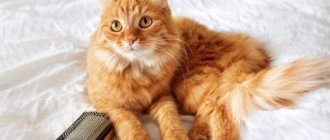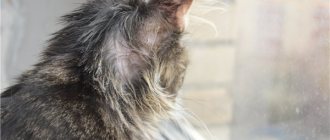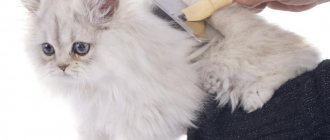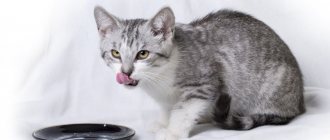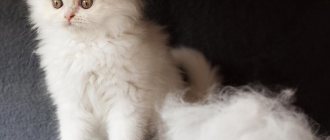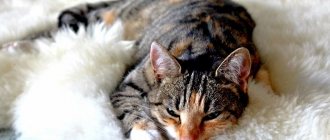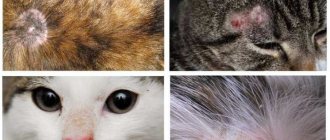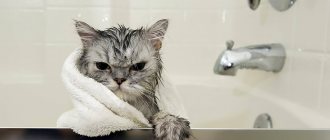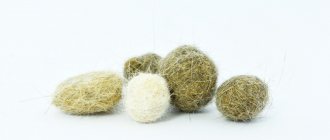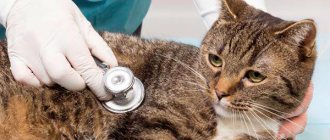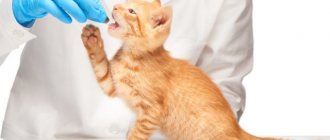Of course, it’s very good that cats are so hygienic. They go to the toilet on their own and also lick themselves, sometimes this procedure takes the cat an hour. However, this is not always good, because in graceful pets, especially long-haired breeds (Maine Coon, Persian breeds, bobtails, Siberian, Burmese, Somali, Norwegian and many other breeds), hair often collects in the cat’s stomach , and an accumulation of lumps occurs. Moreover, in quite large quantities, and it is necessary to remove the wool from there using various methods.
Many owners, when faced with this problem, have a logical question: how to remove hair from a cat’s stomach . And also what are the symptoms , how to understand that there is an accumulation of hairballs in the stomach , and what conclusion to use from there. All these questions, of course, can be answered on the Internet. In this article? you will also find answers, but do not forget that before diagnosing and treating yourself, you first need to consult with a specialist.
Our veterinarian provides the service of calling an experienced veterinarian to your home. This is not only convenient from the point of view of time planning for the owner, but also useful for the pet. After all, not all cats like to go somewhere else. Which can lead to shedding and hair loss, and if the animal begins to lick this fur, then there will be even more lumps and the disease will worsen. Our veterinarian arrives within an hour and, after diagnosis, will prescribe an individual course of treatment. This will help the pet shed fur, as well as return to its normal lifestyle without any health risks.
What danger does fur in a cat's stomach cause?
Of course, the main reason that a cat develops hairballs and also vomits them is cleanliness
.
Already at the age of a month or two, the kitten begins to care for its fur on its own, carefully licking it. Scientists estimate that cats spend about 10 percent of their time licking
, of course while they are awake.
In addition to cleanliness, they thus
regulate body temperature, especially during hot and humid periods of the year or in apartments with dry air. For example, in winter with central heating. A cat also licks itself when it is stressed and needs to relax and calm down.
To get rid of lumps naturally
, the cat vomits them.
However, if something goes wrong
and a complication arises or there is just a lot of hair, a lump in the stomach can cause not the most pleasant consequences. Some owners mistakenly think that this is nature, which means everything will come out on its own without complications. If the problem is not identified in time and the necessary measures are not taken, which will undoubtedly be prescribed by an experienced veterinarian, then there is a risk that the treatment will become more complicated, as will the problem itself.
Why is fur in a cat's stomach dangerous?
- So let's look at why hair getting into the stomach and its accumulation is dangerous for your pet:
- The wool that enters the digestive tract gives the cat a feeling of fullness, because it fills the stomach. Because of this, the cat is able to stop eating; complete exclusion of food and lack of appetite are common in this case. The cat will simply stop coming to the bowl. This is the main danger, because even if the animal approaches the bowl, it will not be for very long and treatment will only become more difficult if the problem is detected too late.
- The intestines become clogged and it is difficult for food to pass through the tract to the end. Because of this, pain occurs in the stomach, problems with digestion appear, the cat is simply unable to go to the toilet on its own, which is why the body even begins to become intoxicated.
- Sometimes hair gets stuck between your pet's teeth, and this can lead to them growing into the gums, which will only cause additional inflammatory processes. This will lead to infections and severe toothache.
- Thus, such problems lead to gastritis and pancreatitis, which, of course, are treated, but they can be avoided. To do this, we will present below the symptoms that you need to know so that complications do not arise and the hairball in the cat’s stomach does not cause injury.
Vomiting in cats shows not only that they have problems in the body and poisoning, but also that there is simply too much hair and it’s time to regurgitate it . The only exceptions, of course, are hairless breeds of cats, for example, Sphynxes. However, if this happens often or does not happen at all, then you should contact an experienced veterinarian. Also if vomiting
does not look like just a piece of fur, but
has some impurities
, it is also worth seeing a doctor who will diagnose and prescribe an individual course of treatment.
The doctors at our veterinary center are real experts in their field, moreover, calling them to your home is much more convenient and beneficial for the cat. The doctor arrives within an hour, because our clinic has strongholds and branches in Moscow and the Moscow region. He always carries everything he needs with him.
The danger of hairballs
Normally, a cat’s digestive tract can digest and eliminate various rough foods: raw meat, bones, skins. However, the stomach of a pet, accustomed to processed foods, cannot cope with such loads. Therefore, hair fibers are not excreted from the body with feces, but accumulate, turning into a lump. If the lump is small and the cat does not have digestive problems, she will regurgitate it herself or deal with it naturally.
Large lumps do not come out on their own, but continue to grow due to the entry of new villi, leading to serious complications:
- loss of appetite, and, as a result, exhaustion - a hairball creates a feeling of fullness in the stomach, which is why the animal eats less and receives less nutrients;
- indigestion - wool irritates the mucous membrane of the stomach and intestines, causing spasms, constipation, diarrhea;
- intestinal obstruction is the most serious complication, which without surgical intervention can lead to the death of the animal.
It is believed that this problem often affects representatives of long-haired breeds. However, old, sick, obese cats, and even young and completely healthy pets during the molting period may also be at risk.
Fur in a cat's stomach: symptoms
It is very important to identify symptoms in the early stages of the disease. This is not so easy to do, because hairballs in an animal, as well as their regurgitation, are a normal situation, which, if it malfunctions, is not always obvious to the pet owner.
- Next, we will look at the main symptoms that determine the presence of a deviation in an animal:
- As already mentioned, the presence of wool in the stomach in large quantities gives a feeling of fullness, which, of course, is false. If it noticeably and often happens that the cat simply comes up to the bowl, eats just a little and leaves, then the fur is probably clogged up in the stomach and digestive tract. The animal also has problems with stool, or more precisely: constipation; it is difficult to go to the toilet when the intestines are clogged with hair. It is worth monitoring how often your pet goes to the litter box and in what volumes.
- This point is a direct continuation of the previous one. Due to the fact that the cat does not eat, its immunity is depleted. The amount of vitamins and minerals is reduced, which means the coat acquires a painful dull color, becomes brittle and stiff.
- It is worth paying attention to your pet’s behavior. If a situation often arises when the cat wants to burp, but cannot, this is a sign that too much hair has accumulated. You need to take a closer look after eating, since that is when this happens most often.
- It is worth examining the cat's teeth and oral cavity. As already mentioned, wool can get stuck in the teeth, which means if it is there, then most likely there is excess in the stomach. Inflammation occurs, so it is necessary to clean the animal’s fangs of foreign objects.
- The pet's mood also changes. Apathy, indifference to games, much more sleep and a sedentary lifestyle. A cat is quite capable of hiding in a secluded corner and sitting there for a long time. This serves as a signal that the pet is sick, although it is not necessarily caused by fur in the stomach, so you should contact the veterinarian in any case.
At the slightest symptoms, you should contact an experienced veterinarian
, who will not only conduct a diagnosis, but also prescribe a course of treatment that will help the pet return to its usual lifestyle, appetite and the joy of playing with its owner.
How to remove fur from a cat's stomach
In order to effectively and competently remove excess hair from the stomach, there are quite a large number of methods. The main ones will be given below. However, this does not mean that you have to do treatment yourself. Only an experienced veterinarian is able to prescribe the course of treatment and the timing required.
in which it must be adhered to so that the illness passes as quickly as possible and without consequences for the pet.
This also guarantees a complete recovery and, perhaps, the doctor will allow the owner to use this method even when the symptoms recur . However, this is still not recommended and it is better to call the veterinarian at home once again to be sure that this is the correct diagnosis and there are no complications.
Basic effective methods to help remove hair from a cat's stomach
And so, the main most effective methods that can be prescribed to the owner in case of hair appearing in the stomach:
1Firstly, this is, of course, natural green grass. The easiest way for those who live in a private house or come to the country. There, the best option would be to let the cat out for a walk in the backyard. Cats intuitively know that grass is medicine. This especially works for cats with long hair. After eating pure green grass, she vomits, and the vomit includes mucus and everything that has accumulated in the intestines that bothered the cat. 2Of course, one of the most popular methods is special food. There are many companies that develop food specifically for cats with long hair. It helps restore the intestinal microflora and rid the animal of hair in the stomach and intestines. The food is impregnated with special products and oils, the fat content of which helps to coat the stomach and remove hair not through vomit, but through feces. Such foods are especially popular and widespread in the fall and spring, when almost all cats shed. The food is selected taking into account the specific tastes of the pet, so you will have to try a fairly large number of foods to choose the one that the animal likes.
3Problems with hair retention in the stomach also arise due to insufficient amounts of minerals and vitamins in the pet’s body. Phytomines will help restore the balance of nutrients. They contain many useful minerals and, in principle, ingredients, there are elements of yarrow, violet, plantain, centaury, solyanka, celandine, licorice and others. They are suitable for pets that are more than six months old, or preferably more than a year old. They are given depending on the breed, age, as well as other characteristics of the pet’s body and specifics. They are identified and identified by experienced veterinarians who have encountered them. 4The paste is also used to remove hair from the body, because it contains vegetable oil and ballast substances. They help improve digestion and restore intestinal microflora. Cats also love it for its pleasant smell. The consistency is a thick paste, similar to toothpaste. It is recommended to add small amounts to food. Again, it is worth noting that only veterinarians prescribe this method. 5If you do not have access to fresh green grass in your backyard, or if the weather in your yard is unfavorable for such grass, then it is recommended to use special grass. It is sold in pet stores and serves the same purpose - to cleanse the stomach and make it healthier. Due to its naturalness and environmental friendliness, it can be used all year round and it will never harm your pet, but will only make it better. Thanks to vitamin B, as well as various amino acids and minerals, this method is practically a panacea for preventing large amounts of hair from entering the pet’s stomach. 6With the help of special treats, which are crispy pillows with a healing filling, they also treat and help get rid of hair in the stomach and digestive tract of the animal. There are different delicacies for every taste: chicken, turkey, fish, just meat, as well as vegetables and various combinations. They are added along with the food as a pleasant addition that your pet will definitely appreciate. Even if the cat is picky and doesn’t like anything new, or doesn’t want to eat because it’s full, it definitely won’t refuse to eat such a healthy treat. 7If the intestines are clogged and the cat is unable to go to the toilet due to constipation, then it is worth using Vaseline oil. It is given to the pet using a syringe without a needle. This liquid has an oily consistency and has no odor, is absolutely neutral, but useful due to its properties. It will envelop the stomach and digestive tract, which means it will be easier to go to the toilet. Most often they give about 4 milliliters, pouring it directly into the mouth using this syringe. However, only a doctor prescribes the exact dosage and time of treatment, because sometimes this simply does not bring benefit and will be a waste of time. 8Walking in the fresh air also helps precisely because there are a lot of different herbs that have healing properties. The cat's nature is characterized by instincts about which herbs should be consumed and will help, and which ones are poisonous or simply cannot have a healing effect. In this way, the cat gets a way to heal itself; moreover, a walk in the fresh air also has a positive effect on the pet’s body and immunity. After such a walk, she vomits hair and everything is restored.
Which method to choose to accurately remove hair from a cat’s stomach?
As you can see, there are many ways, but not all are suitable
in each individual case.
It's worth remembering that some are suitable and some will simply be a waste of time. Only a veterinarian who has already encountered a similar situation in his work can determine what will be useful for a pet and what will not Our expert will diagnose at home and prescribe an individual course of treatment according to the specifics of the cat on site. I am also ready to examine the cat for some time to understand whether such medicinal methods are beneficial or not.
Hair removal
In the warm season, cats enjoy eating green grass.
- Firstly, to cleanse the stomach of undigested food and foreign things (in nature, a predator cat feeds on birds, rodents and other small animals, which leave indigestible fragments in its stomach - claws, feathers, wool). Long blades of grass, irritating the gastric tract, cause natural regurgitation of indigestible components.
- Secondly, the cat eats grass to replenish its body with vitamins and minerals. As a rule, cats choose coarse greens - grasses, sedges or wheatgrass.
